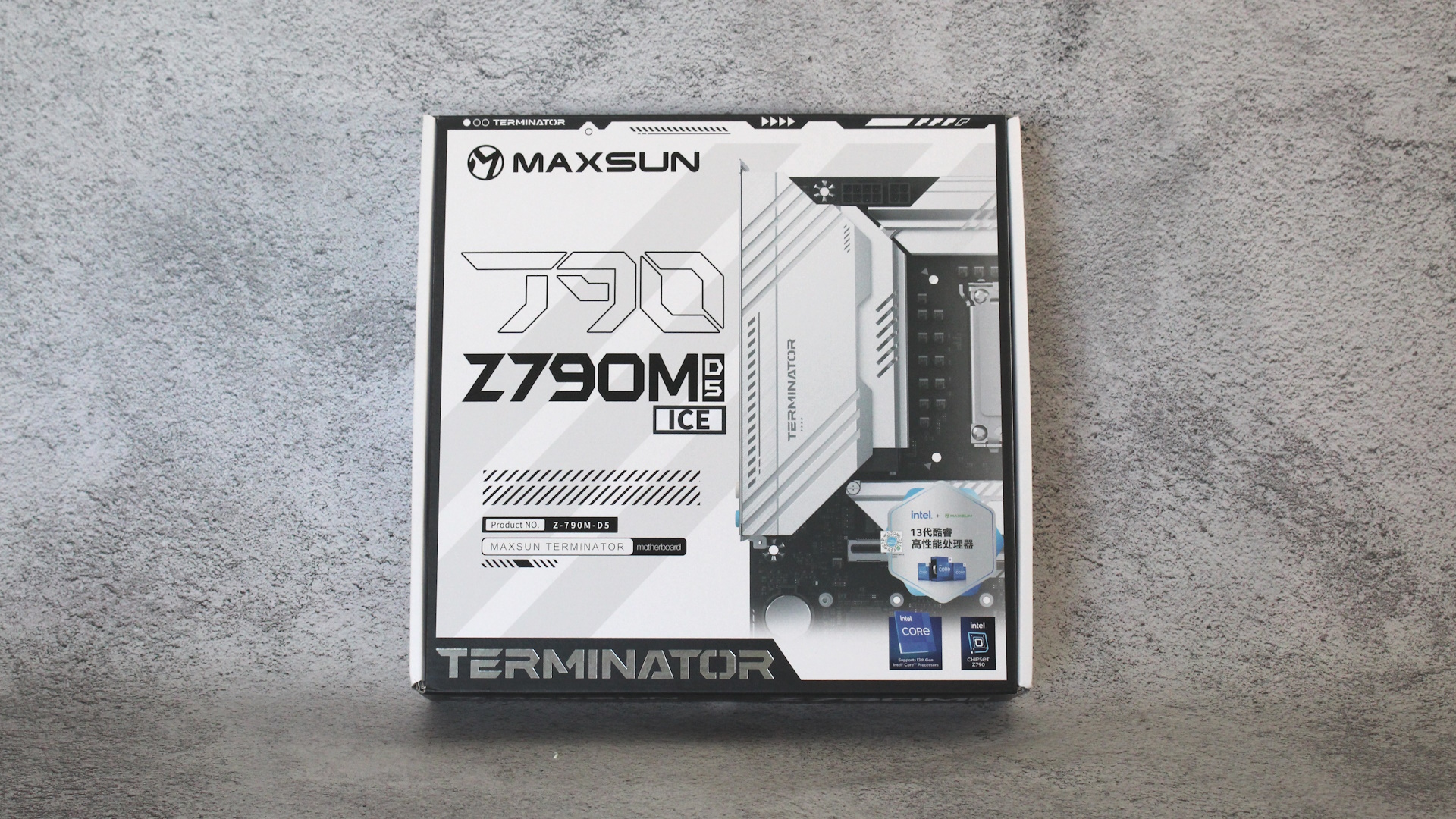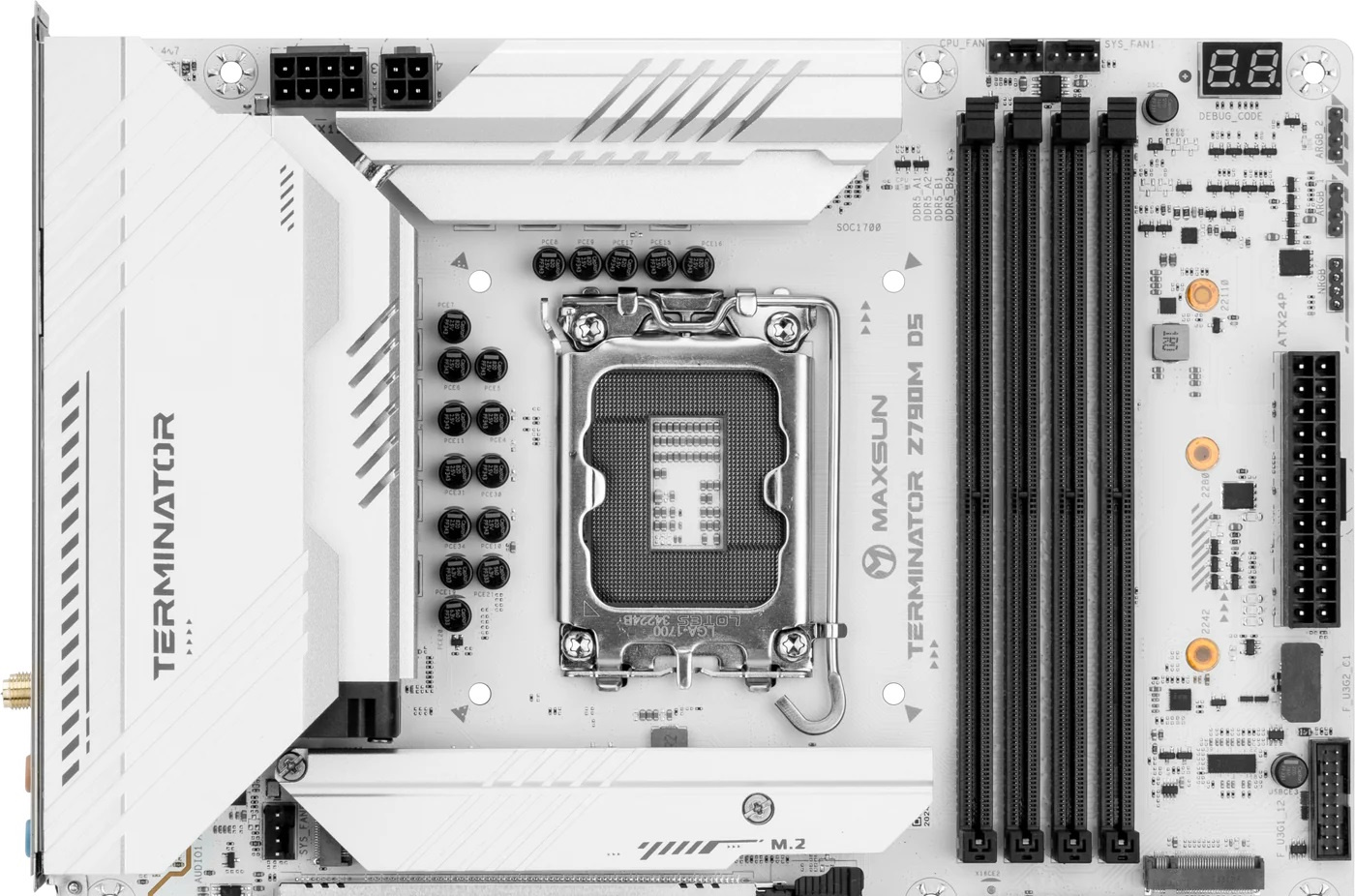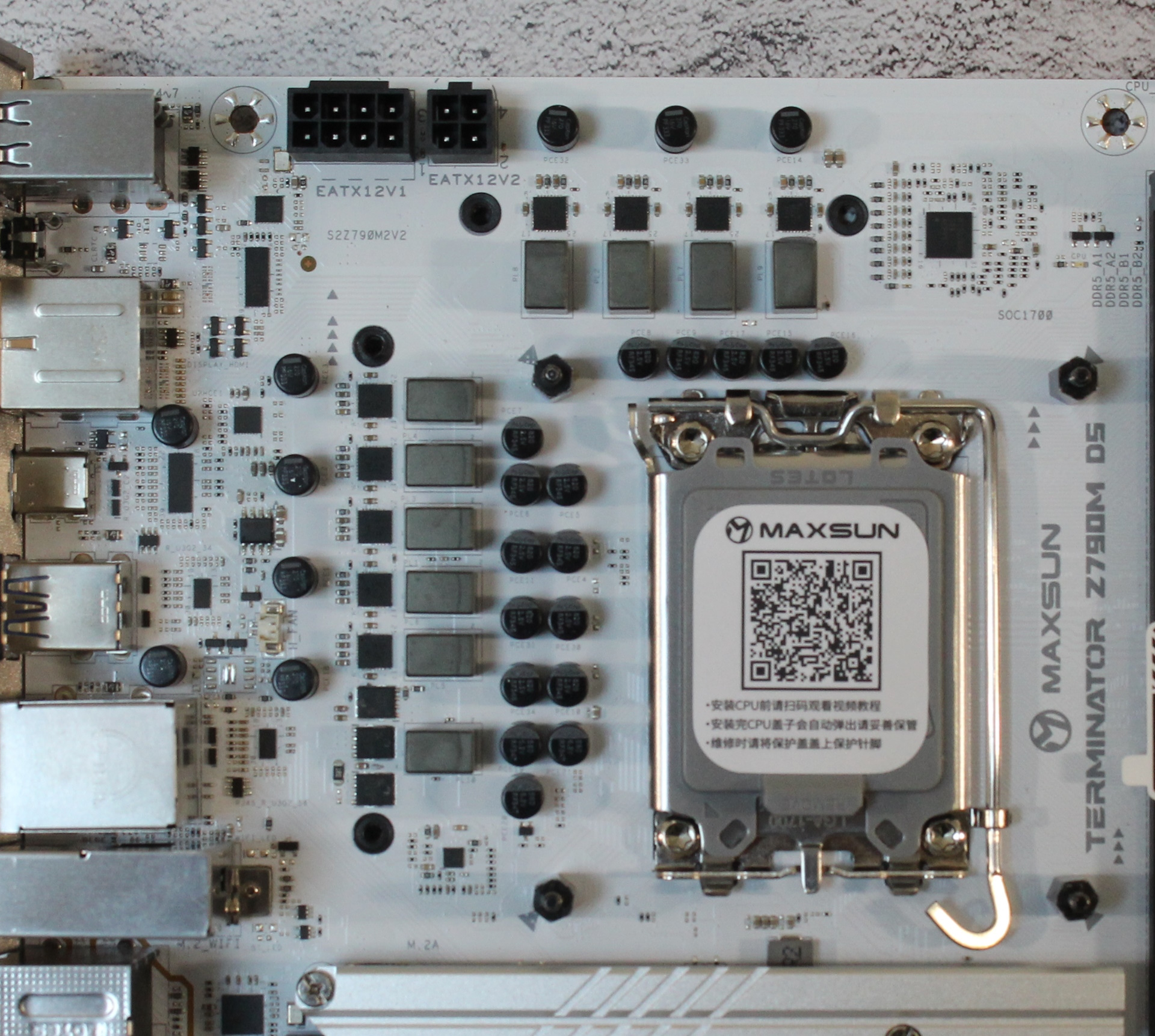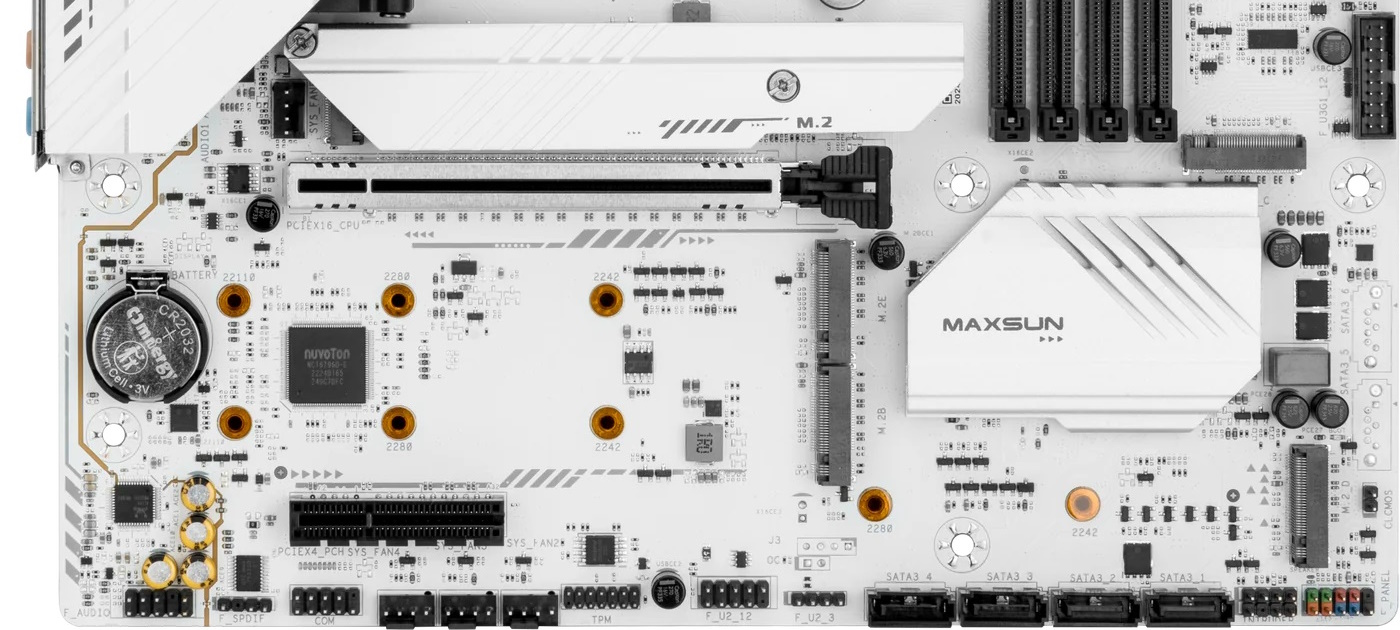Tom's Hardware Verdict
Priced at $189.99, the Maxsun Terminator Z790M D5 Ice is a worthwhile Micro ATX board in the Z790 space. You get five M.2 sockets (all PCIe 4.0), dual 20 Gbps USB Type-C ports, excellent default performance, and a white/silver appearance.
Pros
- +
A lot of storage, incl. 5x M.2 sockets
- +
Front/rear 20 Gbps USB-C ports
- +
Good out of box performance
- +
Sleek white/silver theme
Cons
- -
VRMs run hot with sustained high CPU loads
- -
Lacks PCIe 5.0 M.2 socket
- -
No Windows-based utility
Why you can trust Tom's Hardware
Motherboards with white PCBs have become increasingly popular over the last few years. We’ve seen white cases, white graphics cards, and even white cooling solutions capitalizing on this theme. Maxsun wasn’t missing this bus and came out with a couple of ligther-themed boards, including the Micro ATX Z790M D5 Ice currently on our test bench. The small board packs a punch, presenting users with a lot of storage options (including five M.2 sockets), fast USB with 20 Gbps ports on the front and rear, active VRM cooling, integrated Wi-Fi 6E, and native support for Intel’s 12th- through 14th-gen processors. It’s an impressive specifications list for a mid-range Micro ATX board.
For its MSRP of $189.99, you get a lot of performance out of this board, too. Maxsun sets the default power limits to 253W for both PL1 and PL2, so you get a full 253W of performance so long as your cooling solution can handle it. Power delivery ran hot in longer-running CPU-heavy tests due to the paltry VRMs, but still allowed our flagship-class processor to stretch its legs. In fact, this board was one of the fastest we’ve seen in 7Zip and in the Procyon Office tests, and it was also solid in gaming.
Below, we’ll dig into the details of the board and see how it performed across all of the tests against other full-size (ATX) Z790 motherboards. You can also see if this board made the best motherboard list (it certainly has a chance). But before we get into those details, we’ll start by listing the specifications from Maxsun’s website.
Specifications: Maxsun Terminator Z790M D5 Ice Wi-Fi
| Socket | LGA1700 |
| Chipset | H770 |
| Form Factor | YTX (Horizontal) |
| Voltage Regulator | 10 Phase (8x 50A MOSFETs for Vcore) |
| Video Ports | (1) DisplayPort (v1.4) |
| Row 5 - Cell 0 | (1) HDMI (v2.0) |
| USB Ports | (1) USB 3.2 Gen 2x2 Type-C (20 Gbps) |
| Row 7 - Cell 0 | (4) USB 3.2 Gen 1 (5 Gbps) |
| Row 8 - Cell 0 | (4) USB 2.0 (480 Mbps) |
| Network Jacks | (1) 2.5 GbE |
| Audio Jacks | (5) Analog + SPDIF |
| Legacy Ports/Jacks | ✗ |
| Other Ports/Jack | ✗ |
| PCIe x16 | (1) v5.0 x16 |
| PCIe x8 | ✗ |
| PCIe x4 | (1) v3.0 x4 |
| PCIe x1 | ✗ |
| CrossFire/SLI | ✗ |
| DIMM Slots | (4) DDR5 7600+(OC), 192GB Capacity |
| M.2 Sockets | (3) PCIe 4.0 x4 (64 Gbps) / PCIe (up to 80mm) |
| Row 20 - Cell 0 | (2) PCIe 4.0 x4 (64 Gbps) / PCIe (up to 110mm) |
| Row 21 - Cell 0 | Supports RAID0/1/5/10 |
| SATA Ports | (4) SATA3 6 Gbps |
| Row 23 - Cell 0 | Supports RAID 0/1/5/10 |
| USB Headers | (1) USB v3.2 Gen 2, Type-C (20 Gbps) |
| Row 25 - Cell 0 | (1) USB v3.2 Gen 1 (5 Gbps) |
| Row 26 - Cell 0 | (1) USB v2.0 (480 Mbps) |
| Fan/Pump Headers | (6) 4-Pin |
| RGB Headers | (2) aRGB (3-pin) |
| Row 29 - Cell 0 | (1) RGB (4-pin) |
| Diagnostics Panel | 2-character Digital Debug |
| Internal Button/Switch | ✗ |
| SATA Controllers | ✗ |
| Ethernet Controller(s) | (1) Realtek RTL8125BG (2.5 GbE) |
| Wi-Fi / Bluetooth | Wi-Fi 6E AX211 (160 MHz, BT 5.3) |
| USB Controllers | ✗ |
| HD Audio Codec | Realtek ALC897 |
| DDL/DTS | ✗ / ✗ |
| Warranty | 3 Years |
Inside the Box of the Maxsun Terminator Z790M D5 Ice Wi-Fi
Inside the box are a few accessories to help get your PC up and running without an extra trip to the store. You get two SATA cables, the Wi-Fi antenna, and five screws and mounts for M.2 drives. You’ll need to download the drivers to the board from the Maxsun website.
Design of the Z790M D5 Ice
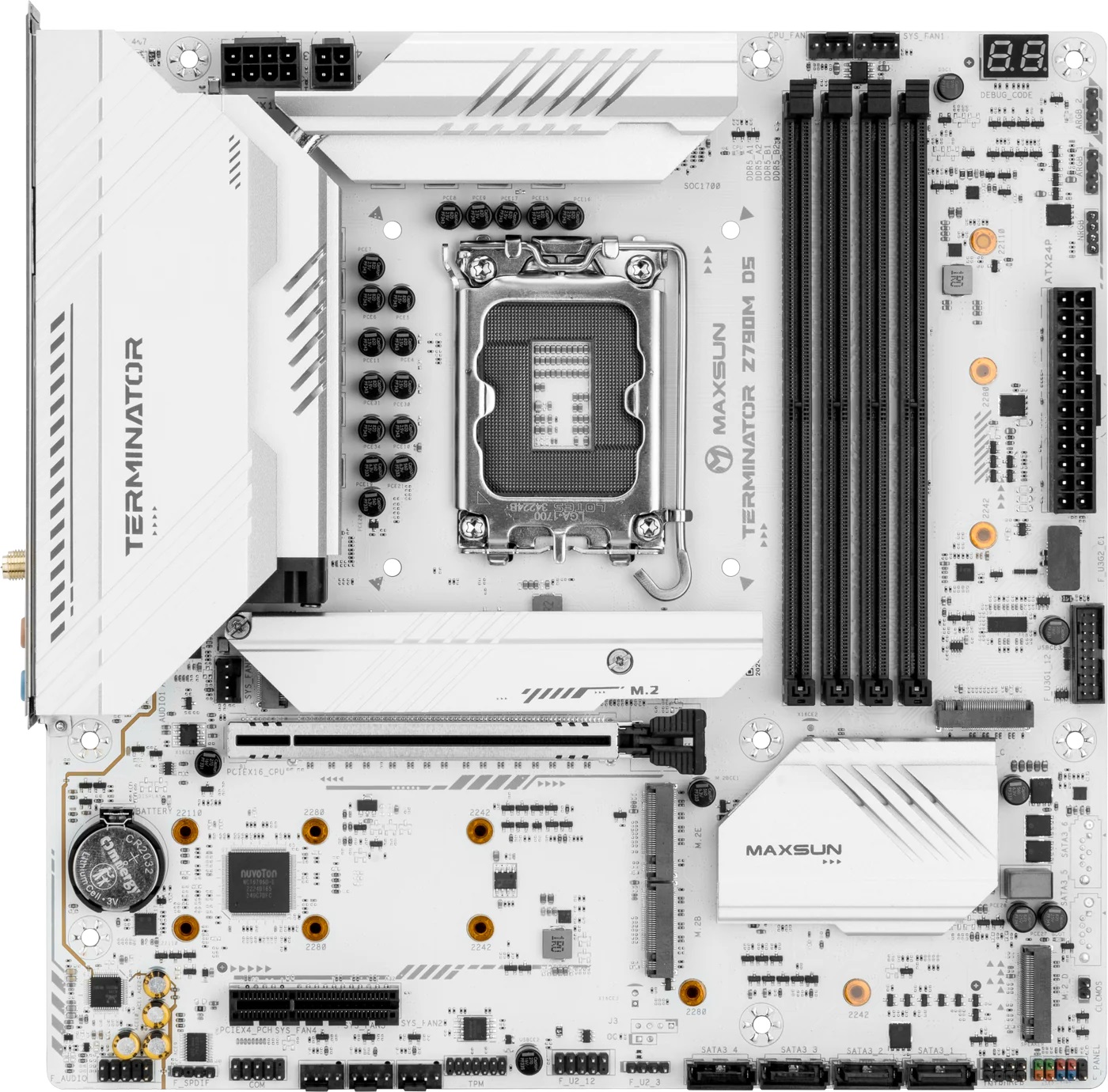
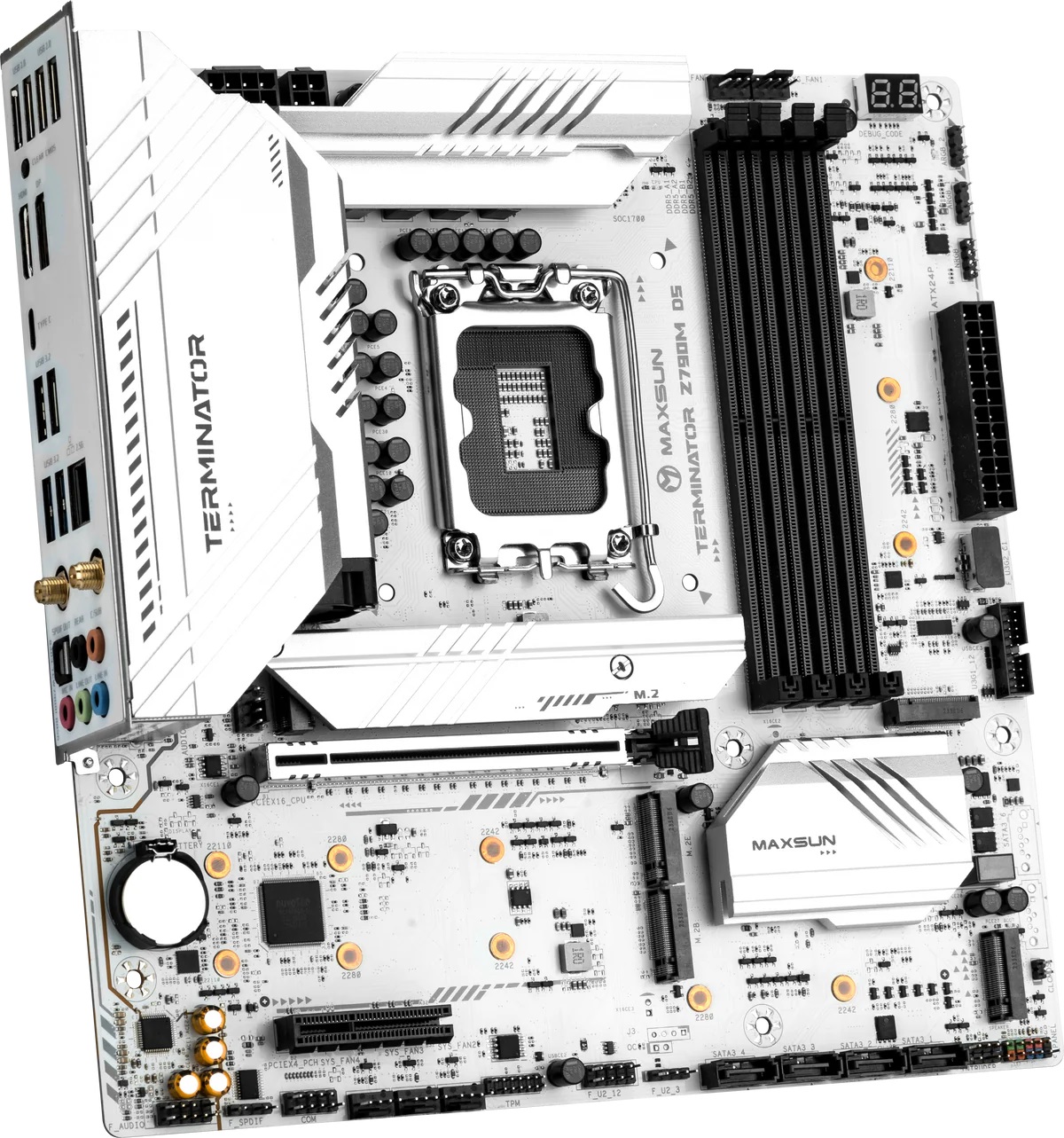
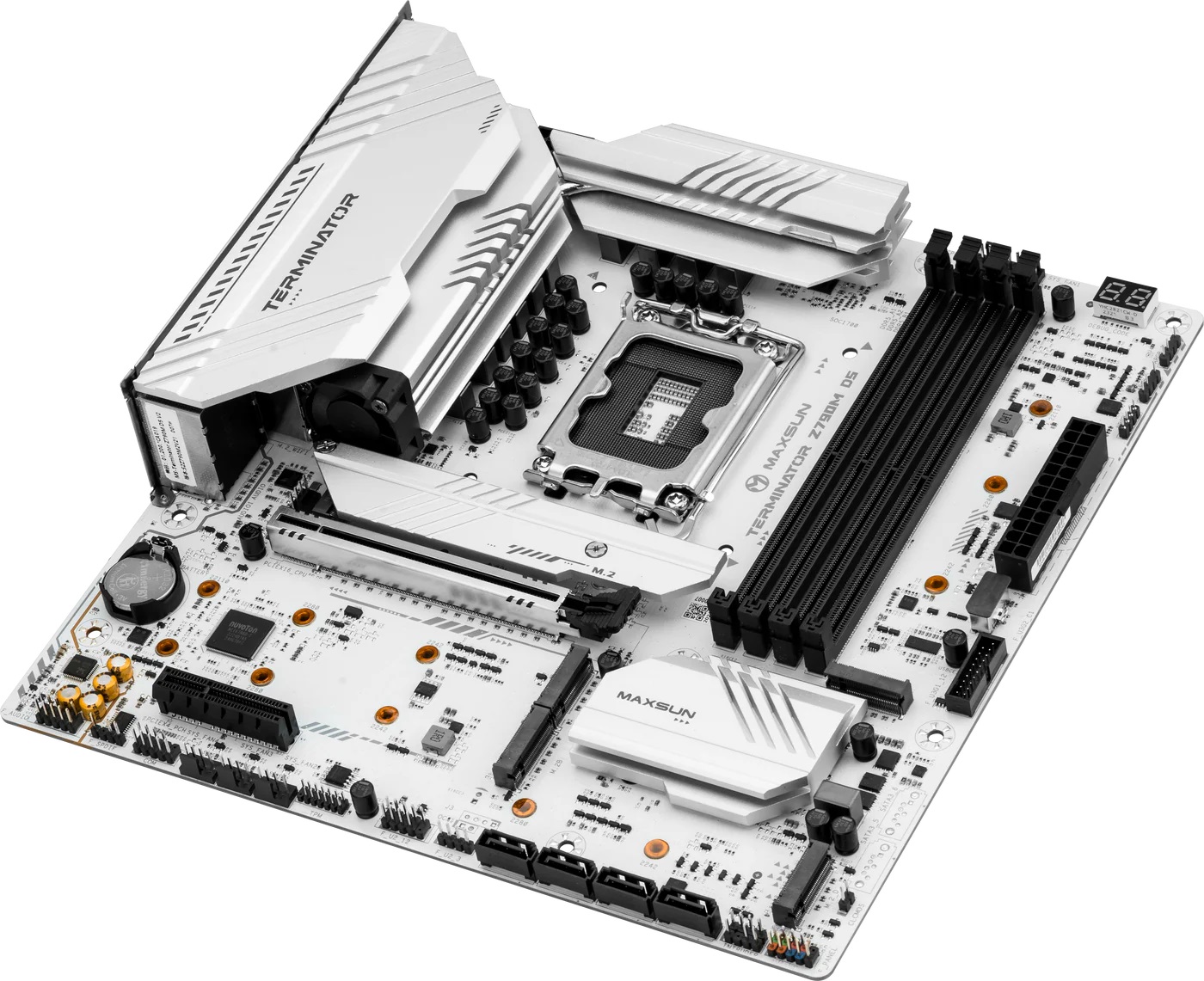
As the name implies, the Z790M D5 Ice is a Micro ATX form factor (245x245mm) board with a white and silver theme. The PCB is white, while the accompanying VRM, M.2, and chipset heatsinks are all silver. Together, it’s a good-looking board and should match plenty of build themes, especially white ones. RGB lighting isn’t integrated, but if you'd like to add your own, there are three headers (two 3-pin ARGB and one 4-pin RGB). Control over any attached lighting is handled through the MaxsunSYNC application.
A rare sighting on Micro ATX boards, the Z790M D5 Ice sports active cooling on the heatpipe-connected VRM heatsinks. A tiny fan sits on the bottom by the top M.2 socket and moves air across the VRMs to improve cooling capacity. Even during heavy, sustained CPU loads, we couldn’t hear the VRM fan over our 3x140mm AIO cooling solution, but they did run hot in that scenario. Overall, we like this board's white and silver look, which will look good in almost any chassis, but particularly if you’re looking at buying a white case.
Starting in the upper left corner, one of the first things we see outside the VRM heatsinks are the two EPS connectors that power the processor—an 8-pin (required) and an optional 4-pin. The large heatsinks have plenty of mass and surface area to whisk heat away from the MOSFETs underneath, but it can be an uphill battle with a high-end processor and sustained loads, which we’ll see later in testing.
Get Tom's Hardware's best news and in-depth reviews, straight to your inbox.
Past the socket area on the right, we find four unreinforced DRAM slots with the sole locking mechanism at the top (the right spot). Maxsun lists support of up to DDR5-7600(OC), which is well past the sweet spot for the platform. We had no issues running our Teamgroup DDR5-7200 kit, and it wasn’t even on the memory QVL. Still, when pushing memory speeds, your best bet for success is using a kit on their QVL list.
Above that are two (of six) 4-pin fan headers. Each header supports PWM and DC-controlled devices. Fan control is handled through the BIOS, but there’s nothing available in Windows now. The online manual wasn't available at this time, but the company confirmed that all headers output 3A/36W. There’s plenty of power, even if you’d like to attach a custom water-cooling solution and pump.
In the upper-right corner, we spy the 2-character debug code display, which helps figure out POST issues. Additionally, it has a POST code LED debug of sorts with LEDs located around the CPU, DRAM, GPU, and another for BOOT. When the board is first powered on, these LEDs will light up depending on where it’s at in the POST process. If there is a problem in that area, the corresponding LED remains lit, and you should have more detailed information on the debug code display.
Moving down the right edge, we run into the three RGB headers, the 24-pin ATX connector that powers the board, front panel USB 3.2 Gen 2x2 (20 Gbps) Type-C connectors, and finally, a 19-pin front panel USB 3.2 Gen 1 (5Gbps) connector. Note, to the left and running vertically is one of five M.2 sockets.
Power delivery on the Z790M D5 Ice is listed as 8+1+1, with eight phases dedicated to Vcore. Power travels from the EPS connector(s) on the rear to the Richtek RT3628AE controller chip, then to the 50A Vishay Sic654 MOSFETs supporting the CPU. The VRMs can handle a flagship-class processor, but be sure there’s adequate airflow in your chassis as the VRMs run hot with sustained heavy CPU loads using an i9-14900K.
On the bottom half of the board, starting on the left, is a fully exposed audio section centered around a Realtek ALC897 audio codec. Surrounding it are four yellow capacitors dedicated to the audio, along with the separation line between the rest of the board and audio traces. I’d like to see better codecs used, but this seems par for most Micro ATX boards.
Two PCIe slots and four M.2 sockets sit in the middle of the board. The top PCIe slot comes ‘armored’ (reinforced) and connects through the CPU, sporting a maximum of PCIe 5.0 x16. If you need to add more expansion cards, this slot also bifurcates to x8/x8. The bottom slot connects via the chipset and runs up to PCIe 3.0 x4 speeds. Nothing is amiss here.
Mixed in among the PCIe slots are four M.2 sockets, with the fifth running vertically, east of the DRAM slots. The top slot, the only one with a heatsink, connects through the CPU and runs up to PCIe 4.0 x4 (64 Gbps) speeds. All other slots run at the same speed. In other words, a PCIe 5.0-capable M.2 socket is not available. Depending on the socket, three fit 80mm modules, while two fit 110mm devices, at least according to the specifications. By look and mounting availability, it appears the board supports three 110mm modules and two 80mm.
Moving right, past the chipset heatsink, we find…nothing! Maxsun moved all of the SATA ports to the bottom edge. The only thing worth mentioning in this area is the Clear CMOS jumper.
Like most boards these days, the rear IO plate on the Z790M D5 Ice comes preinstalled. It sports a white background with grey writing and is generally easy to read. Nine total USB ports: 4x USB 2.0, 2x USB 3.2 Gen1, and one 20 Gbps Type-C are spread across the space along with a clear CMOS button. HDMI and Displayport outputs cover outputs for the integrated video on some processors. A Realtek 2.5GbE network port and Intel Wi-Fi 6E antenna connections cover networking, while audio consists of a 5-plug analog audio stack and an optical SPDIF. If anything is missing here, it’s 10 Gbps USB ports; otherwise, what’s here should be sufficient for most users.
MORE: Best Motherboards
MORE: How To Choose A Motherboard
MORE: All Motherboard Content

Joe Shields is a staff writer at Tom’s Hardware. He reviews motherboards and PC components.
-
8086 The disappearing connectivity on modern motherboards is very disappointing.Reply
Come on people. I want my pci-express slots back. And If I need 5 NVME drives, then I'll get one daughter pci-e card to run them off of. This also frees up motherboard space for other components you and I might desire and makes installing NVME drives much easier since you can just remove the daughterboard vs removing your gpu and everything else to get at the drive location..
https://www.msi.com/PC-Component/M.2-XPANDER-AERO/Specification -
Amdlova 5 nvme will make you better at gaming...Reply
If you need a 10g ethernet or a capture card or other thing you can put on your @ email -
HideOut The lack of M2 5th gen is a bummer, but using badwidth to put put 5 x m2 is cool, especially with 2 x 110mm. But the trend of crappy sound codecs is sad.Reply -
Gu3sts Shame the chipset does not support 36+ pci express lane's so all m.2 & gpu can run at full speed, assuming x4 lanes per m.2 driveReply
